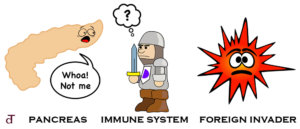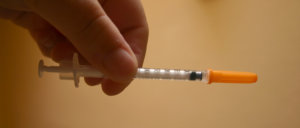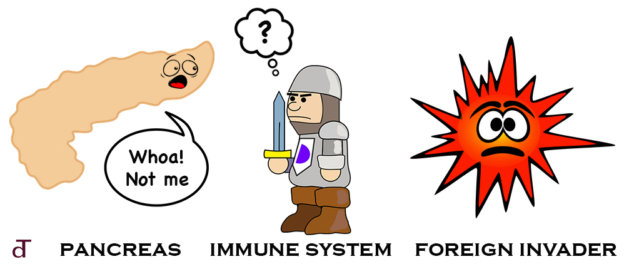
What is Diabetes?
Type 1 diabetes mellitus is described as an autoimmune disease, meaning there is no way to prevent it from affecting a person. Type 1 diabetes is a genetic disorder that is usually diagnosed while the patient is a child; this form of diabetes is caused by the immune system attacking the cells in the pancreas that create insulin. Type 2 diabetes is usually developed later in life and is caused when a persons body does not create enough insulin; this is usually diet-related. Unlike type 2 diabetes, type 1 diabetes cannot be caused due to an unhealthy lifestyle or excess sugar consumption; which can be a common misconception. Only about 5% of people living with diabetes have type 1, according to the CDC (2022). Although type 1 and type 2 diabetes are not the same, they both still can lead to medical complications in the future.
What causes type 1 diabetes?
The American Diabetes Association (2022) has theorized that early diet can have some affect on whether a person will develop type 1 diabetes and reports that infants who are breast fed often have a lower incidence rate of type 1 diabetes. Although they report this to be a “fact,” it is not a widely accepted theory; so for now it remains just that, a theory. According to the CDC, there is no official cause or reason a person gets of type 1 diabetes.
I was diagnosed with type 1 diabetes, does this mean I cannot have sugar?
The incidence of type 1 diabetes typically peaks in adolescents and young adult years. Because of this, many parents of children with type 1 diabetics believe that this diagnosis means that their child can no longer have sugar or sweet treats; this is very far from the truth. People living with type 1 diabetes can still consume whatever foods they choose; they just have to be conscious of their carbohydrate and sugar intake. This is important to be able to administer the correct amount of insulin to correct the potential high blood sugars. Blood sugars can be monitored by using continuous glucose monitoring devices or CGMs.
As mentioned before, type 1 diabetes can go undiagnosed for months or even years and because of this hypoglycemia can account for around 8% of diabetes related deaths (Kelly, 2021). Although it is important to be mindful or sugar “highs” it is also important to monitor for low sugars. While insulin will correct a high blood sugar, it is not the solution for a low blood sugar. Low blood sugars should be corrected by consuming a protein or sugary snack.

What are the treatments for type 1 diabetes?
Currently there is no cure for type 1 diabetes, but there are effective treatment options for patients who have been diagnosed. Treatments for type 1 diabetes include insulin management, blood sugar monitoring, consuming a balanced diet, and exercising. It may be necessary to consume a diabetic diet; which consists of limited or counted carbohydrates. By counting the carbohydrates, it makes it easier for the patient to determine the correct dose of insulin.
Lifestyle Changes
For those diagnosed with type 1 diabetes, it is often assumed that it is going to be necessary to go through an entire lifestyle change and while this may be true is some aspects, it is not for all. Lifestyle changes can seem daunting to someone who has just had their life turned around with a diagnosis of type 1 diabetes. But people living with diabetes are still able to live a normal every day life. Some daily routine changes can include:
- Frequent blood sugar checks
- Counting carbohydrates
- Maintaining a healthy diet
- Adequate amounts of exercise/physical activity
- Daily skin checks to monitor for wounds on the feet or lower extremities
Patients with diabetes are more susceptible to nerve damage, especially in the lower extremities, therefore it is important to monitor for cuts or wounds on the feet and legs. Due to the nerve damage, if a patient isn’t continuously monitoring their skin integrity, a wound can go undiscovered for long periods of time and cause infections. These potential infections can lead to hospitalizations and then in turn cause other health issues. Taking care of your body and promoting your health is an important aspect of daily living.
Reference
Ahmed, A. S., Alotaibi, W. S., Aldubayan, M. A., Alhowail, A. H., Al-Najjar, A. H., Chigurupati, S., & Elgharabawy, R. M. (2021). Factors Affecting the Incidence, Progression, and Severity of COVID-19 in Type 1 Diabetes Mellitus. BioMed Research International, 1–9. https://doi.org/10.1155/2021/1676914.
Center for Disease Control and Prevention. (2022, November 3). What is type 1 diabetes. Retrieved August 18, 2022, from https://www.cdc.gov/diabetes/basics/what-is-type-1-diabetes.html.
Genetics of diabetes | ADA. (2022). American Diabetes Association. Retrieved August 18, 2022, from https://diabetes.org/diabetes/genetics-diabetes.
Kelly, B. (2021). Nursing interventions for people with type 1 diabetes and frequent hypoglycemia. British Journal of Community Nursing, 26(11), 544–552. https://doi.org/10.12968/bjcn.2021.26.11.544.


Hello,
You did an excellent job stating the information throughout the blog post. There is coherence and connection from beginning to end in the post. You use words that are easy to understand for the general audience.
After reading this blog post, I have a better understanding of the difference between type 1 and 2 diabetes. Also, the causes, treatment, and recommendations for those diagnosed with type 1 diabetes. Additionally, I thought people with a diagnosis of diabetes needed to watch or not consume sugar at all, and not, they can actually eat regular food while paying attention to the amount of sugar and carbohydrate consumption.
Thank you,
Karla